|
Let's face it, we all have bad days now and then and moments we'd like to forget. Sometimes it's not easy to just let things go that are bothering or annoying us. We all face problems big and small, and even if we're not thinking about them at the moment, they'll just pop into our brain, start taking over, and affect our MOOD which in turn, will probably affect our whole bowling manner. Unfortunately we are not machines where we can just turn ourselves on and off, so some of us end up carrying these issues with us to the bowling center. If we are in a lousy mood, we need to be AWARE of it before it does affect our game and we end up with lousy scores! When we are worried, we CANNOT FOCUS easily, and if we can't focus, then the following can and most likely will happen as a result: 1. Speed Change-- Worrying makes you feel anxious. This can cause you to walk a faster on the approach and when you bowl too fast compared to normal, it doesn't give the ball a chance to hook as much and your ball may fall short of the pocket. The opposite can also happen. Moods can drain the energy from our body making us feel tired and lethargic which may lead to a slower walking speed causing the ball hook to hook more, making it come up too high on the head pin, and possibly resulting in a nasty split. 2. Not Reaching Out-- If you feel tired, drained from your worries, and not very energetic, most likely you'll just be tossing the ball out onto the lane and dropping it short of where you would normally loft the ball out to. Dropping the ball short means the ball will have more lane to travel on and coming up too high on the head pin and leaving you with a bad pin count or again, a possible split to face. 3. Tense Muscles-- When you're in a bad mood or stressed out from a tough day at the office, muscles can be tense and tight you will not be able to make an effective or rhythmical swing. If you aren't relaxed it will definately affect your score for the worst I'm afraid. If you feel you are tense or something is bothering you, try giving yourself a little pep talk on your way to the lanes. Put on some upbeat music in the car to lighten your mood. Try to put things out of your mind knowing your'e only there for a few hours. Focus on your pre-shot routine, take several deep breaths on the approach before you start your walk (to help ease muscle tension) and make sure you reach out to that certain spot on the lane each time. Do your best to keep your timing and momentum good as well. I know sometimes when I'm in a bad mood, I end up being more annoyed at the bad frame I just had instead of focusing on what to do for the next frame coming up. Try your best to stay positive and don't dwell on past frames. Be deliberate and attack the pins with confidence so your speed will be good. You can play this little mind game that I sometimes like to play. I pretend the problem or person I'm annoyed with is right there in the pocket area and just keep aiming at it. Many times I ended up with several strikes in a row! This doesn't always work, but it's still good to keep in mind. What always works, is being AWARE of your mood or worries before you get to the lanes. Do some mild muscle stretching before you start to bowl and remember that you can only control your game if your'e focusing on the task at hand. Try not to let things distract you because you are only at the lanes for a few hours and you always want to do your best!! Join me back here next week when I'll be discussing "How do I figure out my bowling stats"? Good Luck and High Scoring!
0 Comments
I previously talked about "Lift" and "Turn" in my Blog Post on 10/25/21. As a review, if you hold your ball with a flat hand (palm facing up with the thumb at the 3:00 position and pinky at 9:00) at the stance and also on the downswing and release, the ball will have NO Turn. Turn is any motion from the arm, elbow, hand or the combination of all three working together. The reason we need some turn is to get the ball in the proper position when we release it to create a Hook (curve).
Turn is affected by the different positions we can adjust our hand at the point of release, and there are several ways we can "Turn" the ball in order to achieve good action at the pins. If you think of the face of a clock as a circle which you know is 360 degrees, then if you go from a 12:00 position (the middle fingers are at the 12) to a 1:00 position, that would be a 30 degree turn which is one number on a clock face (12 numbers on the clock divided by 360 degrees=30 degrees). Turning the hand to the right (clockwise) is called a "TURNING OUT" . A "TURNING IN" is when you turn your hand counterclockwise or to the left. This hand rotating is usually done on the backswing and as your arm is coming forward, you turn your hand back to the 12:00 position strongly at the release. "Turning In" and "Turning Out" take practice because sometimes you may turn the hand too much and not turn it back enough. Always try these new things in your practice sessions first, and then bring in to your league play. Just have fun with it !! Here are a few examples of how you can rotate your hand in different positions. Try them in your next practice session to see how these small changes can affect the way the ball will work on the lane: 1. A 90 degree Turning In-- At the stance, hold your hand with the fingers at the 12:00 position and the thumb at the 11:00 position. On the backswing, turn the hand so the thumb is at the 8:00 position (a movement of 3 numbers). You can hold it that way on the release and this is the way to throw a FULL ROLLER track as discussed in my Blog Post from 8/23/21. This type of track will deliver a strong lift because the middle finger dominates and the rotation of the ball as it hits the pins will produce good action. 2. A 30 Degree Turning Out--Hold your thumb at the 10:00 position (fingers at the 12:00 position) and at the top of the backswing, move your thumb to the 11:00 position (only 1 number on the clock face) and then on the downswing move your hand back to the 10:00 position. This is how to throw a SEMI ROLLER track which produces a good hook that is easily controlled. Try to practice this one and really focus on the FEEL because you don't want to turn your hand too soon or it may limit your ability to lift properly. Make sure your timing is good (having the arm and feet in sync with each other). There are other combinations of Turning In and Turning Out that you can try on your own. Practice LIFTING just as you begin to turn the ball, and then maybe lifting the ball a split second after you turn it to see what these little adjustments can do. Even experiment with a 60 degree Turn In and Turn Out. Try holding your hand at the 11:00 position on the downswing and through the release with no turn. The ball will still have a hook on it because you are releasing it with your hand on the side of the ball. Try a CRANK shot by holding your hand with the thumb at the 10:00 position at the stance, and Turning OUT to the 5:00 position and then back to the 11:00 position at the release. It will feel weird because it's unnatural to hold the hand that way, but it will give you a nice hook and lots of action at the pins. Again, have fun and experiment during your practice sessions. Take notes so you can review them before using them in the league once you feel comfortable and confident. Check out my book on Amazon Kindle: https://www.amazon.com/dp/B09ZSMB99G/ref=sr_1_2?crid=P3PQWHFB1WYS&keywords=lets+rev+up+those+bowling+scores&qid=1652035291&sprefix=lets+rev+up+those+bowling+scores%2Caps%2C76&sr=8-2 Join me back here again next week when I'll be discussing "Why it's important to control your emotions in bowling". Good Luck and High Scoring!! There are several problems we can encounter while bowling, and one of them is constantly leaving a ten pin. This can be most frustrating because sometimes I get what looked like a great shot, confidently walk away expecting to have gotten all ten pins down, then turning around and seeing the ten pin staring back at me! UGH, I GOT ROBBED!! If you only leave an occasional 10 pin, there's not much to worry about, but if you leave them often then there is a slight error that needs correcting. First off, make sure you are hitting your mark before making any adjustments because it could be that you are just missing your intended target slightly. If the target is not the issue, then it may be that your ball is going too long (beginning to hook too late), or going too short (beginning to hook too early). Here are a few things I have figured out over the years after leaving several 10 pins that you can try to help you NOT get ROBBED!! 1. You need to OBSERVE your ball when it hits the pins. If the 6 pin wraps around the ten pin or goes through the 9 and 10 pins and misses the 10 pin altogether, then your ball is going too LONG, meaning your'e hitting the pocket too LIGHT. The fix is to move your feet at the stance a board or two to the right (to make the ball go more to the left at the pocket and hit it more solidly). Or, you can move back on the lane 3-5 boards which will give the ball more lane to hook on and have time to come up higher onto the headpin. Keep the same target. 2. If you are hitting HEAVY, that means that the ball is going too short, or hooking too early and coming up too high on the headpin. With this shot, the 6 pin is going in front of the 10 pin and not getting a chance to hit it and knock it down. You will need to move a board or two to the left at the stance and keep the same target. Or you can move forward on the lane 3-5 boards. You can try slowing down your walk to give the ball more chance to hook and come into the pocket more solidly, or speed up your walk if the ball is coming up too high on the headpin. Practice changing speed during your practice session because you want your timing to be good-meaning that the arm and leg movements are in sync with each other. Join me here again next week when I'll be discussing "How Do You Rotate Your Hand in Bowling"? I hope to see you then. Good Luck and High Scoring!! I am posting a day early to wish all you awesome bowling moms a very Happy Mother's Day!! The VIPER OIL PATTERN is the second shortest of these oil patterns I'm discussing and it's about 37 feet in length. 1. This pattern yields medium to high scores. 2. Strokers-- Need to start more to the outside (right side) of the lane where there isn't as much oil, to get the ball started on it's hook toward the pocket. Play a fairly straight line and try the first arrow (5th board) as your target but be careful if you're a beginner. I was so used to playing the second arrow and when I began getting better, I started trying to get strikes using the first arrow and it dropped off into the channel several times. 3. Once the oil begins to break down, different angles can be played and larger adjustments may be needed to find the line into the pocket. 4. Tweeners-- Should start slightly to the left of where the Stroker starts, around the 10th board. 5. Crankers-- Start a little farther left then the Tweeners, maybe on the 15th board. Starting any farther left than this will make it more difficult to get the ball to come back up into the pocket if you should miss your target to the right. The ball will hook a little earlier so you need to be able to control the ball on the back end of the lane. Use a dull ball or you can sand your ball a little before the start of the bowling session. 6. A person who can manage different lines on the pattern as it breaks down will be able to score higher than others. 7. Since oil machines vary slightly from center to center, the Viper Oil Pattern will also vary slightly also if you bowl in different centers for tournaments. Your best bet is to use what I have mentioned here as a starting point. Focusing and observing your ball is the real key in helping you adjust properly. Check out my ebook available on Amazon/Kindle--"Let's Rev Up Those Bowling Scores"! https://www.amazon.com/dp/B09ZSMB99G/ref=sr_1_2?crid=P3PQWHFB1WYS&keywords=lets+rev+up+those+bowling+scores&qid=1652035291&sprefix=lets+rev+up+those+bowling+scores%2Caps%2C76&sr=8-2 Join me next week when I'll be discussing "Why Do I Leave So Many 10 pins"? Good Luck and High Scoring! The more a bowler stands in the center of the lane and throws a straight ball down the center part of the lane, the LESS ANGLE they will have coming into the 1-3 pocket area. It's important to be able to come into the pocket at different angles in order to be successful on the lanes when their conditions are changing, so we need to figure out wether we need to move to the right or left on the approach to determine the best angle for the ball to give us a strike. A "Line" is an angle or path a bowling ball takes as it travels down the lane. OUTSIDE LINE: If you throw a straight ball standing in the center of the lane (20th board) and hit into the 1-3 pocket area, you will most likely get only 9 pins down and leave a "5 Pin". You need to remember that the pins have weight (about 3 1/2 lbs.each) and will cause your ball to "Deflect" to the right for a right handed bowler, and to the left for the lefty's. To compensate for the balls' deflection, you need to move a board or two to the right (left for lefty's). Moving to the Right on the lane is called the "Outside Line" and the ball is usually rolled between the 1st and 7th board. You can use this line when there is heavy oil on the lanes. This line also gives the ball the most pocket power and most action power. If you haven't been carrying the strikes, moving to this outside line and throw directly into the pocket with some speed will be your best bet. 3/4 LINE: The ball will enter on the lane between the 8th and 15th board from the right edge of the lane. Let's say if you release the ball over the 12th board, the ball will go to the right about 5 boards and then start to hook back into the pocket. You must be careful though to not get into an oil track causing the ball to straighten out and not be able to hook back into the pocket. DEEP LINE: The bowler usually stands on the left side of the lane and throws the ball between 15-30 boards from the right edge of the lane, and the ball should go at least 10 to 15 boards to the right before hooking back to the pocket to be classified as a Deep Line. This line is used mostly by those bowlers who throw a large hook (a Cranker) and can be a dangerous line to play especially if the lanes don't have much oil on them. The ball can really cut into the pins at a very sharp angle leaving the bowler with some nasty splits to deal with, so do use this line with some caution. TIGHT LINE: If you stand in the center of the lane (20th Board) and throw the ball over boards 10-15 on the lane, this is considered a Tight Line. This line is popular among many bowlers because the ball will roll straight until approximately 5-6 feet before the pins, then only hook 5-6 boards before coming into the pocket. Because the hook is small, it’s easier to control. "ANGLE" is determined by moving left or right on the approach. It's also determined by the amount of speed and the amount of hook on the ball. If you slow the ball down for example, the ball will hook more and come into the pocket at more of a right to left angle. If you speed up the ball, it will skid more and the angle will be more straight coming into the pocket. You can also increase or decrease angle by varying the amount of Turn and Lift you put on the ball at the release. If you are leaving a lot of 10, 8, 5, or 5-7 Pin spares, then you need to come in at more of an angle. Try moving to the right a board or two more on the approach as a starting point. Try the opposite if you are a left handed bowler. If you are leaving the 7, 9, 5, or 5-10 pin spares, then you need to use less angle and can move more to the left. If you are leaving the 4, 4-9, or 4-7 pin spares, then you are using too much angle and need to move more to the center of the approach. For a lefty, if you are leaving too many 6, 10, or 6-10 pin spares, then you need to move to the right or more to the center of the lane to come in at less angle. For a strike, the ball should be in it's ROLLING PHASE and enter into the pocket around board 17!! I hope you can understand this concept. Keep practicing because the more you practice, the you will improve on playing different angles, and which adjustments you need to make on changing lane conditions. Join me here again next week when I'll be discussing "The Viper Oil Pattern". Good Luck and High Scoring! |
AuthorHello!! My name is Joanie. Although I'm not a professional bowler, I have loved the sport for more than 45 years, averaged over 200 for several seasons, and learned quite a bit with research and experience. Archives
February 2023
Categories |
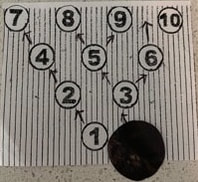
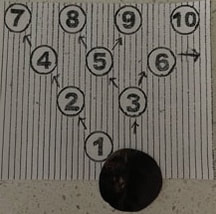
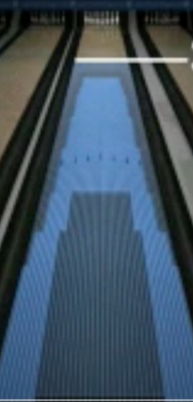
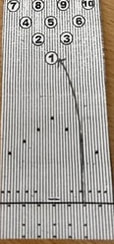
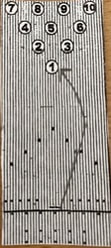
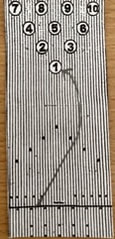
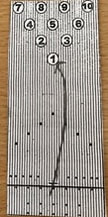
 RSS Feed
RSS Feed